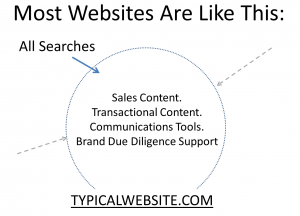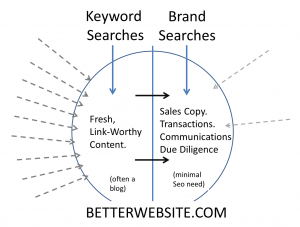I recently presented a concept called “Future Proof SEO” in Lexington which compared how well the typical website are servicing the needs of link builders and social media marketers who are trying to address major ranking factors, and wanted to post the highlights here.
First, I used my minivan example again. Most websites are like minivans – they are designed to do lots of things at a barely competent level. They can accelerate to highway speeds (eventually,) seat several people in relative comfort, and drive pretty much anywhere you like safely. But competitive web landscapes are not places for mediocre performance. You need to think like an F1 car. These cars are ultra-high performance. The suspension and aerodynamics are set up for each track and you must even consider the weather before the race.
Links and Shares Drive Page Rank, Citation Signals and Site Authority. Irresistible, high-value content drives links. This is the Essence of Modern, Future-Proof SEO
On a minivan website, you have the usual content – working to service both the link building and due-diligence roles. “About us,” “history” and “products” may be important for the visitor to use after they’ve found the site, but may not really ideal for linkbuilding or sharing. This is why many sites end up only ranking for branded terms, such as the name of their company!
The real opportunity is in the unbranded search space, but this is far more difficult. You have thousands of other sites competing on the same “track.” This calls for purpose-built, high-performance vehicles at your disposal. And that means an amazing content strategy and no-brainer linking and sharing.
The links and shares hat you can get to obtain this way are generally going to require richer content which is complimentary to the content you’re getting a link from. For social shares, you’re addressing the information thirst of the visitor at the right time. A blog post, for example, which expands on an idea from a popular blogger and supports outreach to that blogger can be a great idea. Another example might be an article which summarizes a presentation or convention combined with an invitation to link to it to the conference organizer or share it on their facebook page, as the audience is ideal! Perhaps a great explanatory video which directly addresses a textual blog post on an authority site. I call these more dynamic elements of the site “Porous” content because they’re specially designed to flow link-juice or social equity votes. They are nimble, contextual and high-octane. They also typically require a solid Content Management Tool with decent SEO friendliness or configurability
So how do you find a way for your website to accomplish this:
- talk about your products or services
- quench the reader’s thirst for useful information
- avoid setting off the visitor’s “promotional content filter”
Divide Up Your Website Conceptually for a Moment
I propose you begin thinking of your site as a conceptually divided space. One part of the site (often a blog) is set up to use for link building. Here is where the gifts of content you create will be posted. The URLs of these will share the top-level-domain of your main site so that inbound links share page-ranking juice site-wide, lifting the entire domain as you make progress with fresh content. This may be a reviews library, an article library, or a blog. It varies by site. But the key is you will use a content management system to regularly post SEO-friendly content there. Simultaneously to ranking improvement, this portion of your site will also be sent traffic from social media shares and other organic sources.
Here (gray arrows representing links) – the site continues to service the due-diligence clients and transactional visits – but has a porous content area ready for linkbuiding. Link equity flows across the site from porous to sales copy, with everything getting the lift.
Once you begin thinking this way (and setting the architecture of the site to achieve it) you will find link building becomes a bit more spontaneous and faster. It makes it clearer how links will provide value to the site, and helps you stop stressing about how you’re going to build more links to that spartan product page!
(race image photo by Oh-Barcelona on Flickr and used under Creative Commons license.)










Link building is a offpage seo…It had two techniques. Link from related blogs and another one deep links..Deep links mean one link is point to the home page. Another links is point to the inner page or post.
I’m not sure if I understand. Deep linking is simply when an inbound link is pointed to a page in the site hierarchy below the top levels – hopefully to a page which is contextually most similar to the linker. As pages are deeper in a site, the context generally narrows and so you can do a better match between the linker and linked site in terms of relevance. Google and Bing assume that the link took more time to plan, and thus more trustworthy.